Does Overhead Press Help Bench Press? | PowerliftingTechnique.com (original) (raw)
The overhead press is a popular exercise among strength athletes because of its ability to build upper body strength. Many in the strength community have said that the overhead press should be one of the staple exercises within every lifter's training program. However, the question still remains whether performing an overhead press helps bench press.
The overhead press will have some degree of carryover to the bench press for certain types of lifters. The lifters who fail their bench press in the mid-range of motion, or touch the bar lower on their chest, will need to develop greater anterior deltoid strength in order to get stronger.
Because the overhead press targets the anterior deltoid more effectively than other exercises, these lifters will get a significant benefit in training the overhead press.
With that said, you'll need to be able to identify whether you have an anterior deltoid weakness to understand whether the overhead press is something you should implement in your training program.
Furthermore, if you do implement the overhead press, there are some considerations you'll want to make to get the most carryover to your bench press.
Read more about How Powerlifters Train Their Shoulders,
Table of Contents
Toggle
- Proper Technique For Overhead Press
- Muscles Used For Overhead Press VS. Bench Press
- Where Is Your Sticking Point In The Bench Press?
- Where Is Your Touch Point In The Bench Press?
- How to Implement Shoulder Pressing Into Your Program
- My Own Experience Using Overhead Pressing
- Other Overhead Press Resources
- Video Guide
- Final Thoughts
- What To Read Next
Proper Technique For Overhead Press
The overhead press is a difficult movement to learn because it requires a certain level of mobility and body awareness. There is also a higher degree of error when the bar moves out of the incorrect bar path. If the bar tracks too far in front of you while pressing, the movement can go from relatively easy to impossible rather quickly.

So if you're new to barbell overhead press, practice using lighter weights and find a bar path that feels natural and strong (check out my article on the suicide grip to understand whether it will work for you when overhead pressing).
Just so we're on the same page, check out the video with Jeff Nippard. It's one of the best technique videos on breaking down how to perform the overhead press properly.
Muscles Used For Overhead Press VS. Bench Press
In order to understand whether the overhead press has carryover to the bench press, we'll need to look at the muscles involved in each movement.
If you have a muscular weakness in the bench press that the overhead press can develop more effectively, then you'll have a greater carryover effect to the bench press.
Muscles In Bench Press
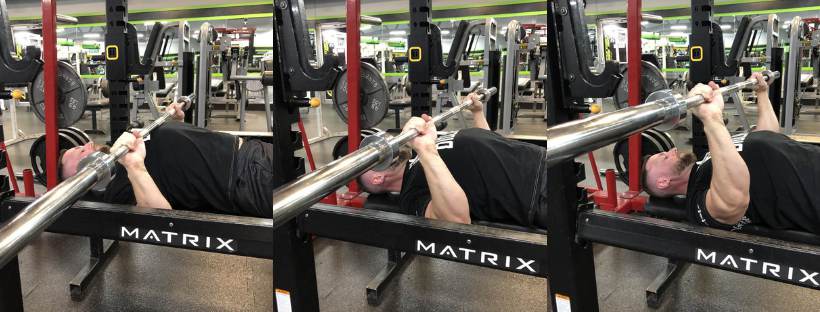
I previously wrote an article covering the muscles used for bench press, so I encourage you to read it if you're interested in learning how muscle activation changes based on grip width, bench angle, and range of motion.
In short though, the bench press utilizes the pecs, anterior deltoids, and triceps.
In the bottom half of the range of motion when the bar is on or near the chest, the pecs are most activated. However, the lower you touch the bar on your chest, for example, below your sternum, the greater your anterior deltoids will be activated.
In the mid-range when the bar is equal distance from the chest and lock-out position, the anterior deltoids are most activated.
In the top range of motion, when the weight is being locked-out, the triceps are most activated.
Regardless of where you choose to grip the bar, whether it's wide or narrow, the shoulders tend to be activated similarly.
Check out more differences in my article on Bench Press vs Overhead Press: Differences, Pros, Cons.
Muscles in Overhead Press
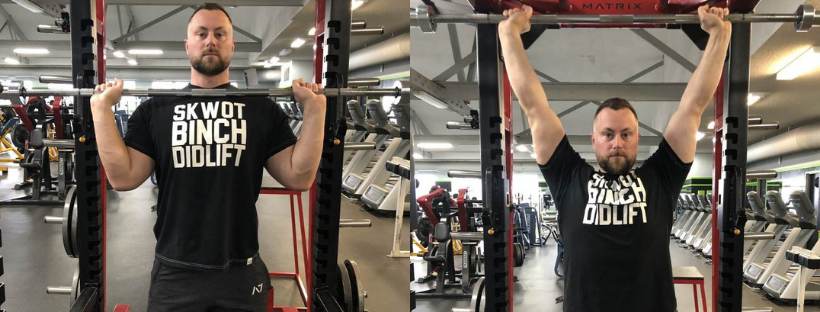
The overhead press shares a lot of the same muscle groups as the bench press, which includes the anterior deltoids and triceps.
The bottom and mid-range of the overhead press have the most anterior deltoids activation. However, depending on how far you ‘lean back' to press the weight overhead, you might activate some muscle fibers of the upper pec. ‘Leaning back' is not advised and you should keep your back as straight as possible.
During the top half range of motion, when the bar is nearing its lock-out position, the triceps are most activated. The primary role of the tricep is to extend the elbow, and if you're completing a full range of motion, the triceps will work to lock the arms overhead.
There are also a lot of stabilizer muscles in the core and back of the shoulder that helps maintain an efficient bar path and upright torso position. However, these muscles aren't relevant when we're talking about carryover to the bench press.
Check out my article on the 9 Best Overhead Press Alternatives
Where Is Your Sticking Point In The Bench Press?
Now that you know what muscles are responsible for each movement, you'll want to identify where your sticking point is in the bench press. If the muscles responsible for your sticking point can be developed using the overhead press, then it might be an effective strategy for getting stronger.
Failing In The Bottom-Range
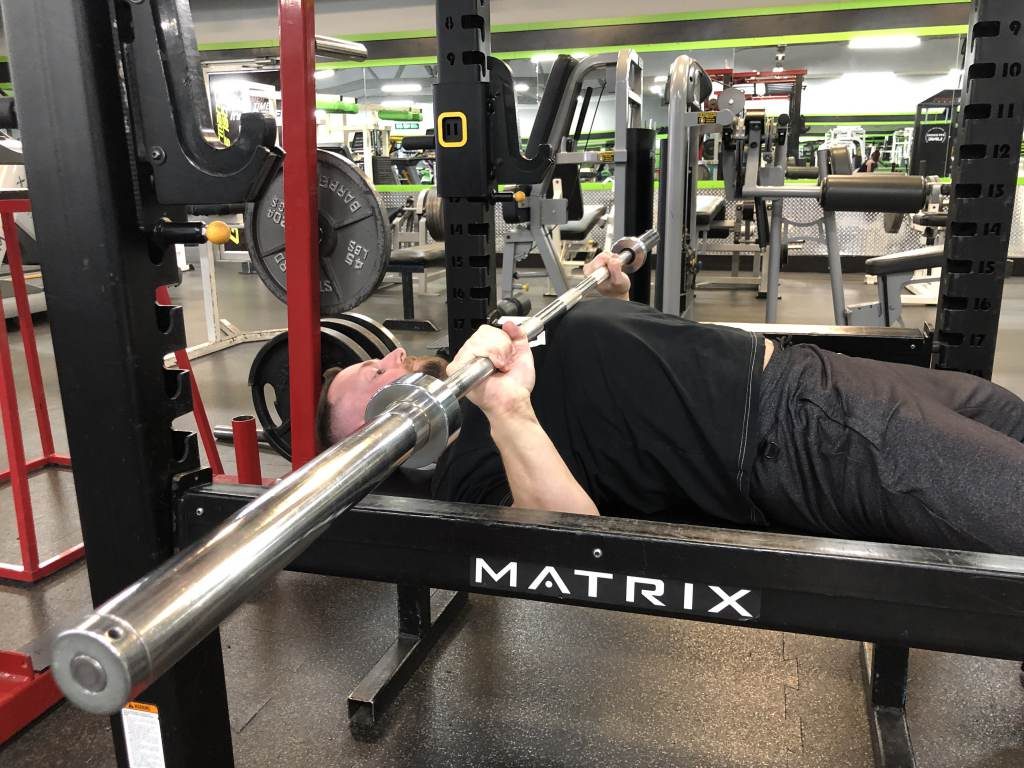
Bottom range of motion on the bench press
If you fail the bench press in the bottom-range of motion, this means that your pec muscles are the weak link.
The overhead press has very little pec activation. So, if you're failing in the bottom-end for bench press than the overhead press won't emphasize the muscles required to break through your sticking point.
In this case, the overhead press will have no carryover to bringing up your bench press numbers. However, there is one exception to this, which I'll explain in the next section.
Another overhead press variation I recommend to advanced powerlifters is the Z-Press (click to check out my complete exercise guide).
Failing In The Mid-Range
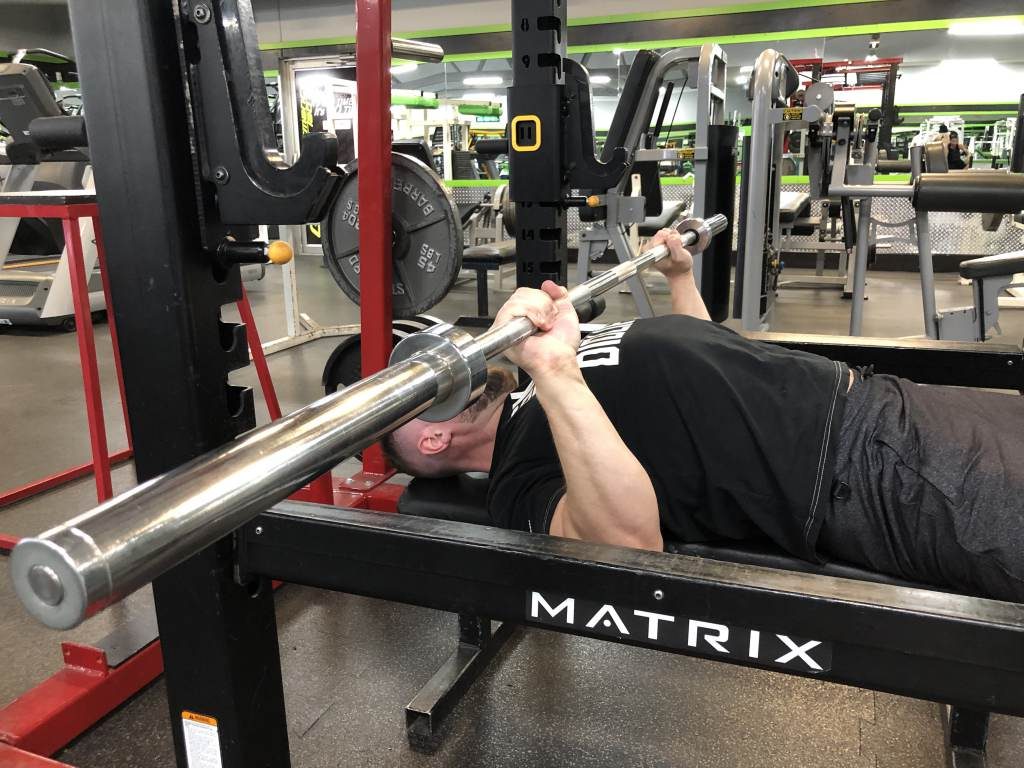
Mid-range of motion on the bench press
If you fail in the mid-range of the bench press, this means that your anterior deltoids are the weak link.
The anterior deltoid has greater activation during the overhead press when compared with the bench press. So, if you're failing in the mid-range, it would be a good tool in building up the strength required to overcome your sticking point.
In this case, you're probably a good candidate to implement overhead pressing into your training program, and you would get a solid carryover to your bench press. This is one of the points I make in my article on How To Increase Your Bench Press Without Benching.
Read more about Should Powerlifters Do Incline Bench Press
Failing In The Lock-Out
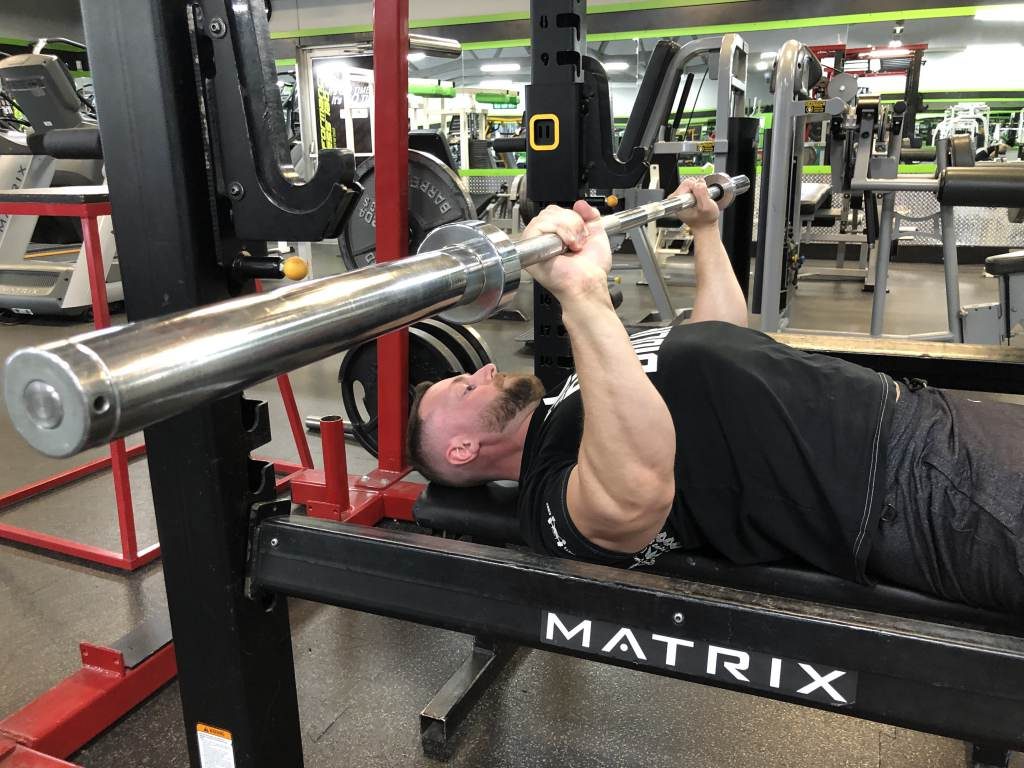
Top range of motion on the bench press
If you fail in the top-range of the bench press, this means that your triceps are the weak link.
While the overhead press and bench press both use the triceps to extend the elbow, I don't believe that the overhead press is the best exercise to develop lock-out strength. If you want to develop a stronger lock-out, exercises such as board bench press or narrow grip bench press will put more emphasis on the triceps than the overhead press.
In this case, I would not implement overhead pressing for any lock-out weakness. It would only have marginal carryover to the bench press and you would have more effectiveness choosing another exercise.
Where Is Your Touch Point In The Bench Press?
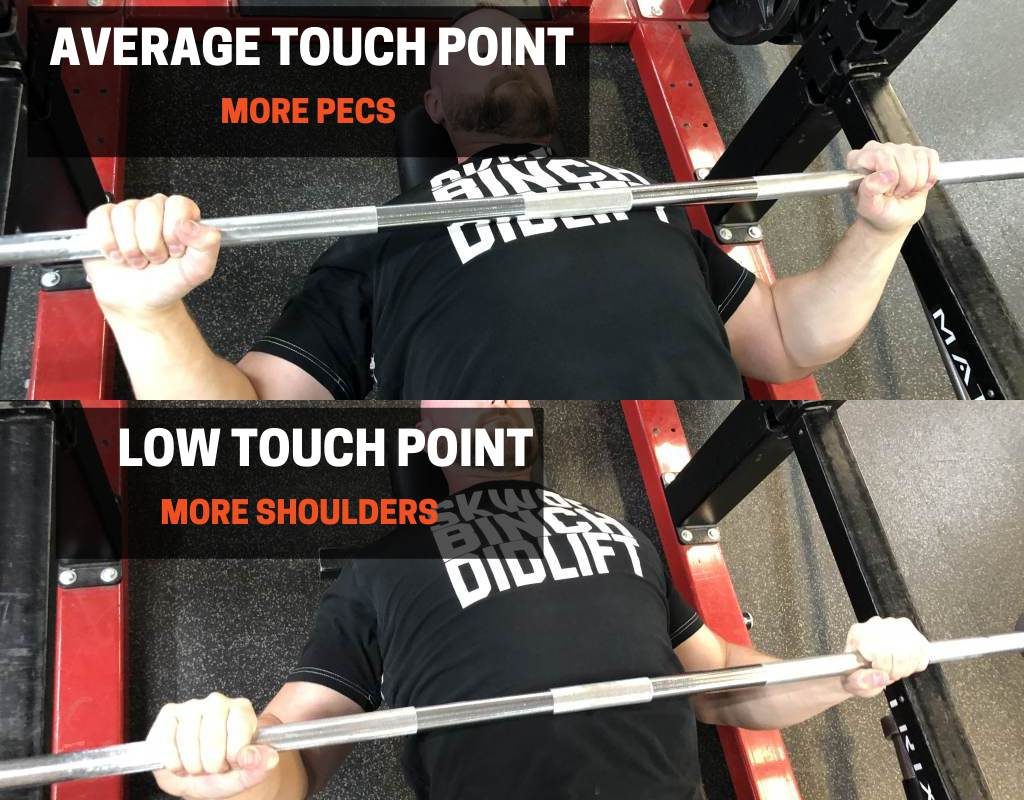
Read my other article that discusses Can You Train Back And Shoulders Together?
I just said that the overhead press will likely have no carryover to your bench press if you have a sticking point in the bottom range. However, there is one exception to this and it depends on where you touch the bar on your chest.
The lower you touch the bar on your chest, the more anterior deltoid activation will be required to press the bar up and back into the lock-out position.
Most lifters will touch the bar on their chest somewhere between their nipples and sternum. If you're touching the bar lower than your sternum, that's okay, but you'll need greater shoulder strength to do so.
Note: Check out my complete guide on the bench press touchpoint, which will depend on your grip and arm length.
If you find yourself failing on your chest in the bench press, and at the same time you recognize that you have a lower touchpoint, then perhaps your anterior deltoids are the weak link. In this case, the overhead press may be a good exercise to build the strength required to overcome this deficiency.
Another option might simply be to touch higher on your chest so that you're using more pecs than anterior deltoids, but that's something you'll need to experiment with to see if it works for you.
If you're someone who does upright rows but needs some extra variation in your program, then check out my article on the best upright row alternatives.
How to Implement Shoulder Pressing Into Your Program
If you have a specific anterior deltoid weakness then the overhead press will be a useful tool to overcome this deficiency.
With that said, you'll want to be careful in substituting overhead press with bench press in your training program.
If you want to get stronger in the bench press, you'll need to maintain a high level of specificity.
This idea of ‘specificity' simply means that in order to adapt positively the stimulus needs to be specific to the outcome. In other words, if you want to get stronger in the bench press, you still need to focus on progressively overloading the bench press more than any other exercise.
For example, if you bench press twice per week, then you should continue to bench press twice per week and focus on adding more volume and/or intensity to this movement over time.
What you don't want to do is substitute one of your bench press days for an overhead pressing day, which would reduce your frequency and specificity of bench press training.
Instead, simply add in the overhead pressing following one of your bench press days as a supplement to the overall bench press training program.
Related Articles:
- 9 highly Effective Bench Press Alternatives
- 3 Cable Shoulder Workouts For Mass (Complete Guide)
- Does Dumbbell Bench Press Help Your Barbell Bench Press?
- Does a Strong Back Help Bench Press? (Yes, here’s how)
My Own Experience Using Overhead Pressing
From my own personal experience, I found there to be diminishing returns with the carryover from my overhead press training to bench press numbers. What this means is that my bench press improved by training overhead press, but only to a certain point.
When I identified I had an anterior deltoid weakness with my bench press, I started implementing overhead pressing. My overhead press went from sets of five at 185lbs to 225lbs over the course of several months. At the same time, my bench press strength improved and I can confidently say I had a decent amount of carryover.
However, trying to get my overhead press above 225lbs didn't yield any further carryover to my bench press. This was because I was focusing too much on getting a stronger overhead press for the sake of getting a stronger overhead press, and I ignored the exercises that would continue developing my bench press.
In other words, I was lacking sufficient bench press specificity to continue getting results in the exercise that I was trying to develop. I opted to maintain my overhead strength at 225lbs and focus on more bench-specific training.
Gain a deeper understanding of strength training benchmarks by exploring our insights on what percentage of people can bench 225 lbs.
Other Overhead Press Resources
- Can You Overhead Press Every Day? (Pros and Cons)
- 17 Exercises To Improve Bench Press Strength (That Actually Work)
- Overhead Press In Gyms With Low Ceiling (7 Tips)
- Bench Press vs Overhead Press: Differences, Pros, Cons
- Can You Overhead Press Every Day? (Pros and Cons)
- 13 Overhead Press Cues To Increase Strength (With Pictures)
- What Is The Best Overhead Press Grip Width & Hand Placement?
- Is It Better to Do Shoulder Presses Standing or Sitting?
- Why Is My Overhead Press So Weak? (7 Fixes That Work)
Video Guide
Here's a video from one of our coaches. It explains why it makes sense to use overhead press to help bench press.
Final Thoughts
The overhead press will help your bench press if you have a specific anterior deltoid weakness. If you're failing in the mid-range of the bench press, or have a lower touchpoint, you'll want to bring up the strength in your anterior deltoids. The overhead press is one of the best movements to increase anterior deltoid strength.